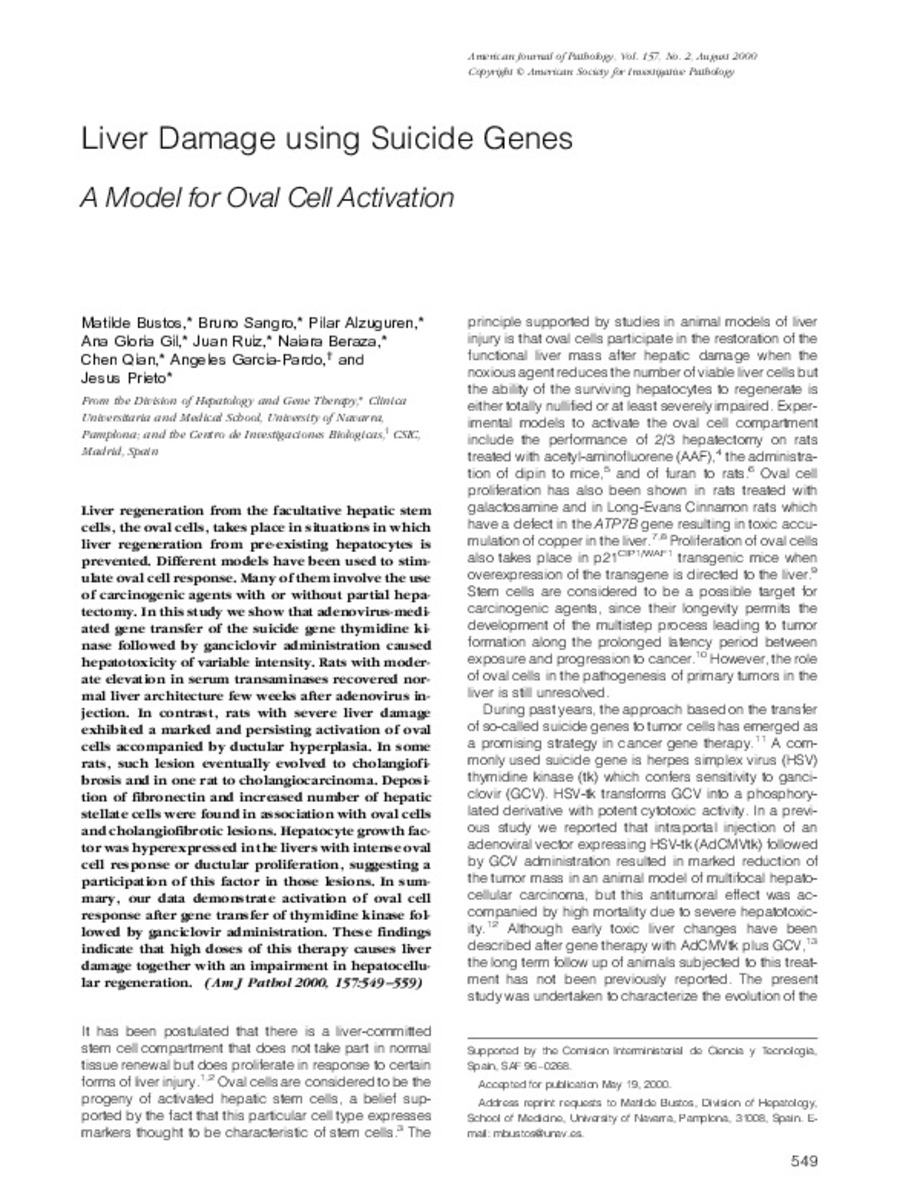Registro completo de metadatos
| Campo DC | Valor | Lengua/Idioma |
|---|---|---|
| dc.creator | Bustos, M. (Matilde) | - |
| dc.creator | Sangro, B. (Bruno) | - |
| dc.creator | Alzuguren, P. (Pilar) | - |
| dc.creator | Gil, A.G. (Ana Gloria) | - |
| dc.creator | Ruiz, J. (Juan) | - |
| dc.creator | Beraza, N. (Naiara) | - |
| dc.creator | Qian, C. (Cheng) | - |
| dc.creator | Garcia-Pardo, A. (Ángeles) | - |
| dc.creator | Prieto, J. (Jesús) | - |
| dc.date.accessioned | 2012-10-16T07:57:53Z | - |
| dc.date.available | 2012-10-16T07:57:53Z | - |
| dc.date.issued | 2000 | - |
| dc.identifier.citation | Bustos M, Sangro B, Alzuguren P, Gil AG, Ruiz J, Beraza N, et al. Liver damage using suicide genes. A model for oval cell activation. Am J Pathol 2000 Aug;157(2):549-559. | es_ES |
| dc.identifier.issn | 0002-9440 | - |
| dc.identifier.uri | https://hdl.handle.net/10171/23390 | - |
| dc.description.abstract | Liver regeneration from the facultative hepatic stem cells, the oval cells, takes place in situations in which liver regeneration from pre-existing hepatocytes is prevented. Different models have been used to stimulate oval cell response. Many of them involve the use of carcinogenic agents with or without partial hepatectomy. In this study we show that adenovirus-mediated gene transfer of the suicide gene thymidine kinase followed by ganciclovir administration caused hepatotoxicity of variable intensity. Rats with moderate elevation in serum transaminases recovered normal liver architecture few weeks after adenovirus injection. In contrast, rats with severe liver damage exhibited a marked and persisting activation of oval cells accompanied by ductular hyperplasia. In some rats, such lesion eventually evolved to cholangiofibrosis and in one rat to cholangiocarcinoma. Deposition of fibronectin and increased number of hepatic stellate cells were found in association with oval cells and cholangiofibrotic lesions. Hepatocyte growth factor was hyperexpressed in the livers with intense oval cell response or ductular proliferation, suggesting a participation of this factor in those lesions. In summary, our data demonstrate activation of oval cell response after gene transfer of thymidine kinase followed by ganciclovir administration. These findings indicate that high doses of this therapy causes liver damage together with an impairment in hepatocellular regeneration. | es_ES |
| dc.language.iso | eng | es_ES |
| dc.publisher | Elsevier | es_ES |
| dc.rights | info:eu-repo/semantics/openAccess | es_ES |
| dc.subject | Antiviral Agents/pharmacology | es_ES |
| dc.subject | Gene Therapy/adverse effects/methods | es_ES |
| dc.subject | Genetic Vectors/administration & dosage/genetics | es_ES |
| dc.title | Liver Damage using Suicide Genes A Model for Oval Cell Activation | es_ES |
| dc.type | info:eu-repo/semantics/article | es_ES |
| dc.relation.publisherversion | http://ac.els-cdn.com/S0002944010645658/1-s2.0-S0002944010645658-main.pdf?_tid=9a1f62dd0c78f708eda4d16256129ee5&acdnat=1340094285_1d50bd8346575b87f179297306a5549f | es_ES |
| dc.type.driver | info:eu-repo/semantics/article | es_ES |
Ficheros en este ítem:
Estadísticas e impacto
Los ítems de Dadun están protegidos por copyright, con todos los derechos reservados, a menos que se indique lo contrario.






